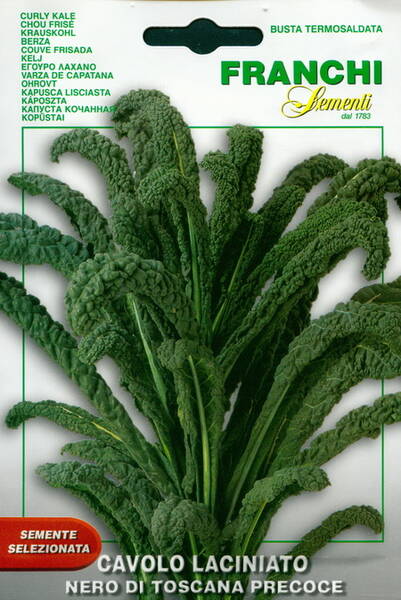Your shopping cart is empty!
Kale "Nero di Toscana precoce"
Brassica oleracea L. convar. acephala (DC) Alef var. sabellica L.
1.79€
Ex Tax: 1.45€
Ex Tax: 1.45€
Curly kale "Nero di Toscana precoce".
Early variety: ripens 53 to 65 days after transplanting. The total plant height reaches 90 cm.
Leaves are dark green, structure resembles Savoy cabbaqe leaves, verv one mantle.
Very hardy: the quality of products only improves after frost - it becomes even sweeter.
Dark green, juicy and tasty leaves 5-8 cm wide and 25 cm long (it is better to pick them when they are young and tender).
Marketable yield of leaves is 4.0-7.0 kg / m2.
This traditional cabbage from Tuscany is not only very attractive, but also known as "Black Palm", "Calais Palma" or "Black Tuscan".
It is the closest relative of wild cabbage.
In terms of the content of vitamins and minerals, it surpasses white cabbage.
This Italian variety has a very strong stem, on which there are huge, long, bubbly leaves with a bluish bloom, coquettishly wrapped inward.
Used fresh, for soups and can decorate not only food, but also tne flower bea. Plants will tolerate frost.
The cold encourages the accumulation of sugar in leaves, so after frost leaves acquire a specific mild sweetish taste.
The value of the variety: resistance to low temperatures (up to -18°C), decorative, high taste and dietary qualities.
Increases immunity, lowers blood cholesterol levels, improves the functioning of the digestive tract.
Used for soups, side dishes, vegetable stews, cabbage chips.
Fresh collard greens are most useful, since many of their valuable properties are lost during heat treatment. It goes well with vegetables, garlic, basil and green onions.
In a healthy diet, it is used to make smoothies and vegetable juices. Leaves can be frozen for the winter, salted and pickled.
Fresh leaves are stored for two weeks in the refrigerator in a bag or plastic container.
Agrotechnics.
Sowing is done in early spring (as soon as the soil can be cultivated). It germinates best during cool periods in moist soil.
The crop is harvested by picking off individual leaves.
There is no need to rush to harvest the main crop, since lowering the temperature has a positive effect on the palatability. Keeps perfectly frozen.
Early variety: ripens 53 to 65 days after transplanting. The total plant height reaches 90 cm.
Leaves are dark green, structure resembles Savoy cabbaqe leaves, verv one mantle.
Very hardy: the quality of products only improves after frost - it becomes even sweeter.
Dark green, juicy and tasty leaves 5-8 cm wide and 25 cm long (it is better to pick them when they are young and tender).
Marketable yield of leaves is 4.0-7.0 kg / m2.
This traditional cabbage from Tuscany is not only very attractive, but also known as "Black Palm", "Calais Palma" or "Black Tuscan".
It is the closest relative of wild cabbage.
In terms of the content of vitamins and minerals, it surpasses white cabbage.
This Italian variety has a very strong stem, on which there are huge, long, bubbly leaves with a bluish bloom, coquettishly wrapped inward.
Used fresh, for soups and can decorate not only food, but also tne flower bea. Plants will tolerate frost.
The cold encourages the accumulation of sugar in leaves, so after frost leaves acquire a specific mild sweetish taste.
The value of the variety: resistance to low temperatures (up to -18°C), decorative, high taste and dietary qualities.
Increases immunity, lowers blood cholesterol levels, improves the functioning of the digestive tract.
Used for soups, side dishes, vegetable stews, cabbage chips.
Fresh collard greens are most useful, since many of their valuable properties are lost during heat treatment. It goes well with vegetables, garlic, basil and green onions.
In a healthy diet, it is used to make smoothies and vegetable juices. Leaves can be frozen for the winter, salted and pickled.
Fresh leaves are stored for two weeks in the refrigerator in a bag or plastic container.
Agrotechnics.
Sowing is done in early spring (as soon as the soil can be cultivated). It germinates best during cool periods in moist soil.
The crop is harvested by picking off individual leaves.
There is no need to rush to harvest the main crop, since lowering the temperature has a positive effect on the palatability. Keeps perfectly frozen.
Curly kale. Bot.: Brassica oleracea var. acephala












